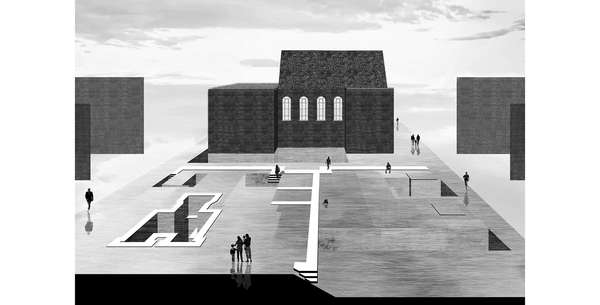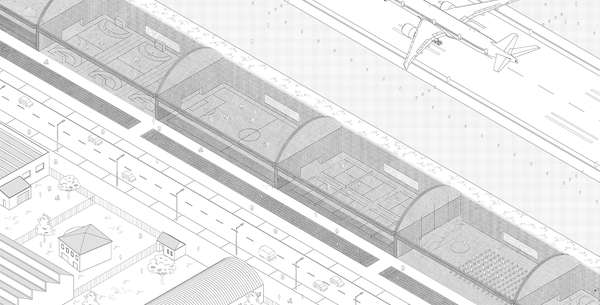The Limits of Landscape

The Lisbon urban periphery is a consolidated landscape. But to what extent is that landscape collectively shared? What are the boundaries between architecture and landscape? How does society welcome and appreciate, or depreciates, the production of its own built space? And what contribution can architecture make to taming an urban scenario that is commonly viewd as negative? Dealing with territory that his less likely to be on the tourist itinerary, this exhibition is the result of a call for proposals in the scope of the Future Architecture Platform.
Photography is a recognized means of reconstructing the landscape. It operates in the domain of the subjective, altering the way in which we learn about the physical world. Nuno Cera’s images of Amadora capture the confrontation between urban development as a speculative process and the permanence of fragments of diverse uses. The farming fragments that remain encounter forgotten streets and colourful commercial spaces nurture strong social connections and new ways of life. To overcome the false dialectic between a lost paradise and the contemporary city, it is necessary to amplify the visibility of urban qualities. It is necessary to expand the limits of the landscape, acknowledge the reality in an objective way and find, in the domain of architecture, the tools to enhance its qualities.
In the footsteps of the aqueduct by Manon Mollard
From the Casa da Mãe de Água Velha all the way to the Depósito das Amoreiras, the Águas Livres aqueduct traverses the region of Amadora, uninterruptedly intersecting both farming land and urban settlements. Yet this engineering masterpiece has become invisible today, its form lost in the Lisbon conurbation, swallowed up by the unfettered urban sprawl. The city vs country dichotomy is no longer relevant. We have to make sense of the diffuse immensity, and make it measurable. At a time when territories are endlessly subdivided, the aqueduct can once again become a structuring element in a new spatial continuum. What better way to reorganize a territory than reinvigorating one of its major historical axes?
The aqueduct’s route is dotted with a series of tall vertical structures. A beam of light connects the top of each viewing tower to the next on, creating an indented horizontal profile in the night sky, new territorial landmarks. As the aqueduct’s morphology responds to the topography it traverses – running close to the ground, arching over valleys and concealed under hills and made visible only by the presence of skylights on the surface – these conditions create distinct opportunities for increasing interaction between the people and their immediate surroundings. A new form of usufruct of the landscape. Light and views, vegetation and air, water and ruins together contribute to anchoring the city in its own context. When you understand how a landscape works and what lies behind it, you enjoy it differently.
Common Places: Urban Playgrounds by Plan Común
The exhibition is focused on public space, taking Amadora as an example of a conventional (neglected) city that is the ideal testing ground for new spatial intervention strategies in this type of urban fabric, which reveals the worst aspects of generic development.
To address this scenario, Plan Común – a Chilean/French studio based in Santiago and founded in 2012 – invited a series of young architecture practices around the world to discuss, reflect on and design a series of ‘Micro-Public Spaces’, a concept borrowed from the Japanese architects Atelier Bow-Wow and understood as a collection of pocket squares, playgrounds and small public spaces which foster social interaction and new urban behaviours.
The ‘Common Places: Urban Playgrounds for Amadora’ exhibition presents a series of strategies that could help to reimagine Amadora through a series of micro-public spaces that could also be reproduced in other similar contexts. The main goal is to offer up new pointers and open up debate on this topic. The family of proposals could be tested, appropriated, adapted and applied in different cities in the world with similar characteristics to Amadora. From common places to an urban plan.
Contributors: Plan Común, Bruna Canepa, Marcelo Cox, Dyvik Kahlen, Hamed Khosravi, Ciro Miguel, NP2F, Tsubame Architects, Lavinia Scaletti, Tiago Torres-Campos and Umwelt.
During the 4th edition of the Lisbon Architecture Triennial Form of Form (5 Oct - 11 Dec 2016), the Satellites exhibition explores problems in dialogue with the architectural and historical specificity of the sites where it happens. Taking place at several sites in Lisbon and surroundings, Satellites offer visitors the opportunity to find different urban contexts and create a complex interpretation of the architecture of the city entering naturally in the set of the Triennial. The Limits of Landscape is a part of Satellites exhibition that is drawn from the Future Architecture platform, with authors Manon Mollard, Nuno Cera and Plan Común.

